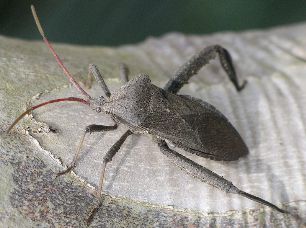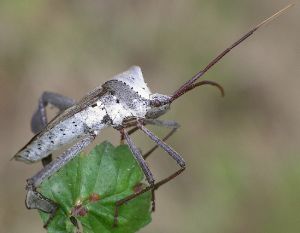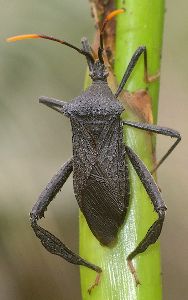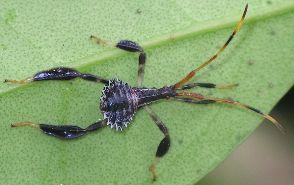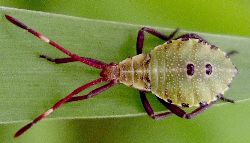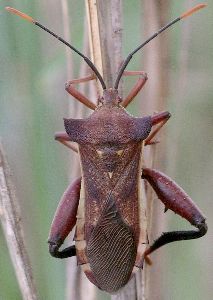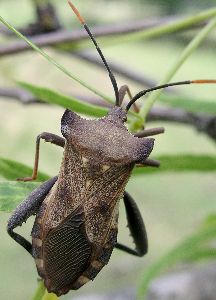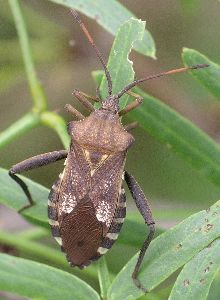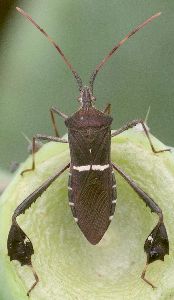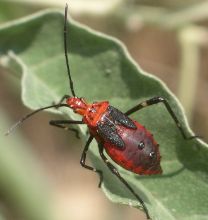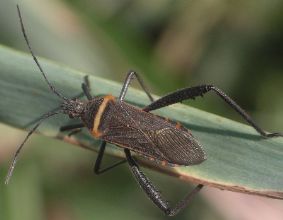
| Coreidae ~ Leaf-footed Bugs |
page 1 ![]() page 2
page 2
|
The coreids are one of my favorite groups of insects. I am sure it is partly because they are not miniscule and, in fact, are often rather large and showy. They also don't fly away as often as, say, butterflies or dragonflies. The nymphs are easy to see, hang out with the adults, and they are sometimesfrequently delightfully colorful or oddly shaped. There are a decent number of genera and species to hold one's interest, but it is not overwhelming. These insects are commonly called leaf-footed bugs or squash bugs, but there are many species that do not have the wide and flattened tibiae and only a few actually feed on squash. All members of this family feed on plants, and some are partial to certain kinds.
Acanthocephala femorata gets its name from the swollen hind femurs on the male. The females have more slender legs, but both genders can be recognized by their large size, brown color, and antennae that are all reddish.
The largest member of this genus is Acanthocephala declivis. It is a dusty gray color and is hard to misidentify. It is frequently found during the winter, especially when cleaning up fallen leaves or gardens. On warm days they might come out to sun themselves. By far the most common species in our area is Acanthocephala terminalis, named for the red to yellow color of the tips of the antennae. This species also frequently has light colored feet too, and its body color can be dark brown to black. At times, I've seen up to six pairs mating on the same branch, and adults of this species are most likely to be found in small groups.
The Acanthocephala nymphs are very unique looking. The early instars often hold their round, flat abdomens upwards as they slowly crawl around on their long legs. The edge of the abdomen is decorated with a zigzag fringe, and all their legs are a bit flattened and leaf-like. The nymphs of A. declivis are a striking black with red highlights, while those of A. terminalis are more black and white. As is the case with all the coreids, the older nymphs start to look more like the adults so they are easier to recognize.
The genus Leptoglossus contains the classic leaf-footed bugs. The hind tibiae have large flared processes that resemble the shape of leaves. When these insects fly, their back legs hang down and they are easily mistaken for wasps, which also drag their hind legs in flight. They also buzz like wasps. In fact, this genus seems to have several tricks for discouraging predators. The nymphs are orange and black, a universal warning signal indicating bad taste or toxins in the insect world. They frequently feed in groups, which enhances the visual effect of the colors.
There are four species of Leptoglossus that I've found in our area. L. phyllopus is very common and can be found feeding on various plants, especially yucca blossoms and seed pods. They have a broad, solid white band across their backs, which distinguishes them from the other species.
Another commonly seen species is Leptoglossus zonatus. This one is the most gregarious, with large groups of adults and nymphs sometimes feeding on plants such as Jimsonweed (Datura inoxia). L. zonatus is quite variable in appearance. The best identifying feature is a pair of round light-colored patches on the pronotum, but these might be either very obvious or almost invisible. The white band that goes across their back is never solid; instead it is zigzagged and might be thick or so thin that it almost disappears. The least common species is L. oppositus, which looks very much like L. zonatus with no light patches on the pronotum and only four white dots at the ends of where the zigzag lines should cross the wings.
Leptoglossus clypealis is the most colorful of this genus. Whereas the base color for the other species is dark brown, L. clypealis is usually lighter and has prominent white stripes on the sides of the abdomen where other species have thinner ones. The flare on the hind tibiae is much less. The most surefire way to identify this species, though, is by its head: there is a little projection sticking out of the front between the antennae. Leptoglossus clypealis feeds on various plants, but is also frequently found on juniper.
A coreid that looks very much like Leptoglossus minus the leg flanges is Dallacoris picta. The genus name for this one used to be Phthia. The coloration on both nymphs and adults is rather variable, with nymphs ranging from dark orange to bright red and having various amounts of dark markings, while adults are brown with orange edges. The amount of orange can vary and the orange bar across the pronotum can be absent. The species is rather host specific, preferring to feed on plants in the Solanaceae family. In our area they like Silver-leaf Nightshade (Solanum elaeagnifolium). |
page 1 ![]() page 2
page 2
![]()
